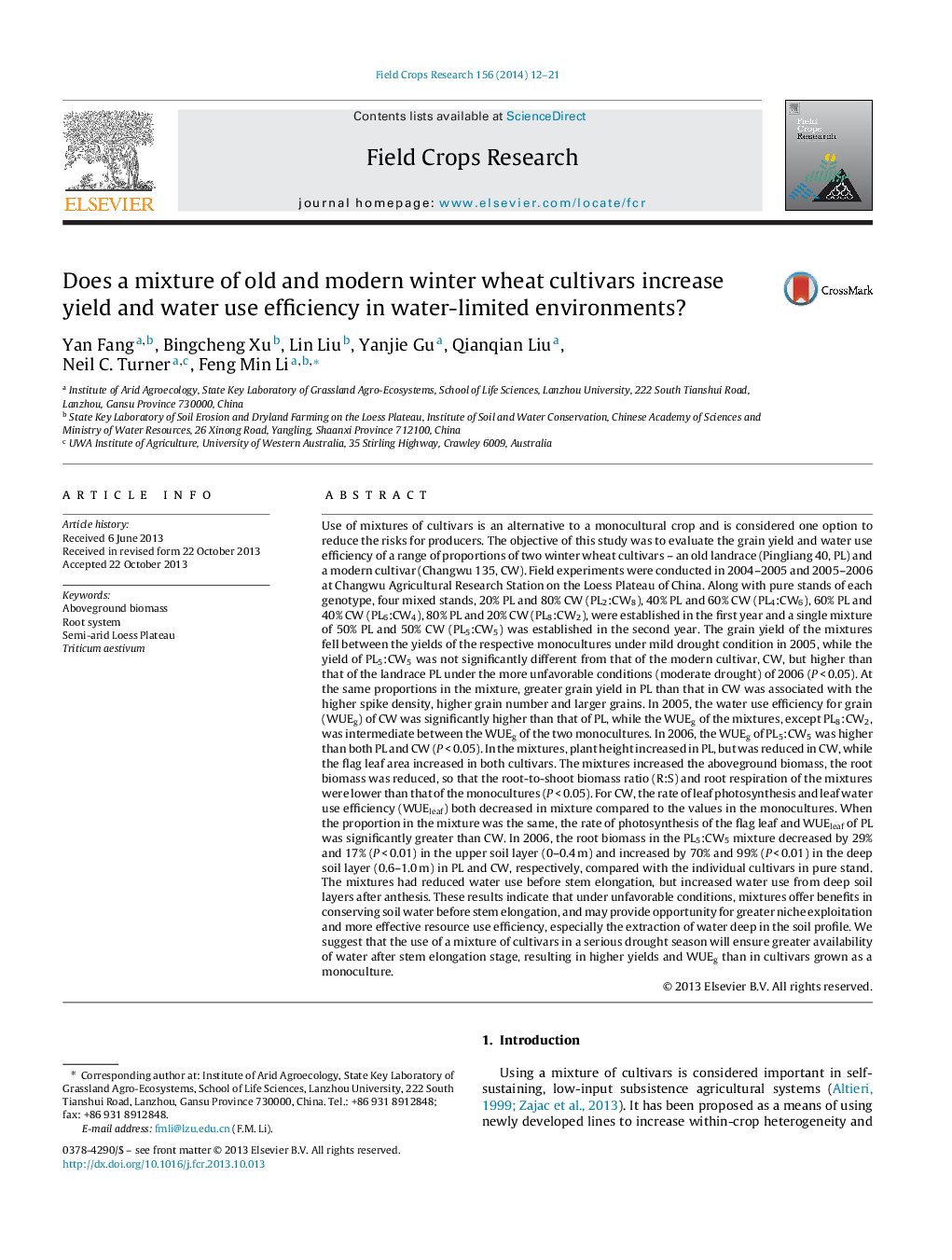| کد مقاله | کد نشریه | سال انتشار | مقاله انگلیسی | نسخه تمام متن |
|---|---|---|---|---|
| 6375104 | 1624707 | 2014 | 10 صفحه PDF | دانلود رایگان |
عنوان انگلیسی مقاله ISI
Does a mixture of old and modern winter wheat cultivars increase yield and water use efficiency in water-limited environments?
ترجمه فارسی عنوان
آیا ترکیب مخلوط ارقام گندم زمستانی قدیمی و مدرن باعث افزایش عملکرد و بهره برداری از آب در محیط های محدود آب می شود؟
دانلود مقاله + سفارش ترجمه
دانلود مقاله ISI انگلیسی
رایگان برای ایرانیان
کلمات کلیدی
موضوعات مرتبط
علوم زیستی و بیوفناوری
علوم کشاورزی و بیولوژیک
علوم زراعت و اصلاح نباتات
چکیده انگلیسی
Use of mixtures of cultivars is an alternative to a monocultural crop and is considered one option to reduce the risks for producers. The objective of this study was to evaluate the grain yield and water use efficiency of a range of proportions of two winter wheat cultivars - an old landrace (Pingliang 40, PL) and a modern cultivar (Changwu 135, CW). Field experiments were conducted in 2004-2005 and 2005-2006 at Changwu Agricultural Research Station on the Loess Plateau of China. Along with pure stands of each genotype, four mixed stands, 20% PL and 80% CW (PL2:CW8), 40% PL and 60% CW (PL4:CW6), 60% PL and 40% CW (PL6:CW4), 80% PL and 20% CW (PL8:CW2), were established in the first year and a single mixture of 50% PL and 50% CW (PL5:CW5) was established in the second year. The grain yield of the mixtures fell between the yields of the respective monocultures under mild drought condition in 2005, while the yield of PL5:CW5 was not significantly different from that of the modern cultivar, CW, but higher than that of the landrace PL under the more unfavorable conditions (moderate drought) of 2006 (PÂ <Â 0.05). At the same proportions in the mixture, greater grain yield in PL than that in CW was associated with the higher spike density, higher grain number and larger grains. In 2005, the water use efficiency for grain (WUEg) of CW was significantly higher than that of PL, while the WUEg of the mixtures, except PL8:CW2, was intermediate between the WUEg of the two monocultures. In 2006, the WUEg of PL5:CW5 was higher than both PL and CW (PÂ <Â 0.05). In the mixtures, plant height increased in PL, but was reduced in CW, while the flag leaf area increased in both cultivars. The mixtures increased the aboveground biomass, the root biomass was reduced, so that the root-to-shoot biomass ratio (R:S) and root respiration of the mixtures were lower than that of the monocultures (PÂ <Â 0.05). For CW, the rate of leaf photosynthesis and leaf water use efficiency (WUEleaf) both decreased in mixture compared to the values in the monocultures. When the proportion in the mixture was the same, the rate of photosynthesis of the flag leaf and WUEleaf of PL was significantly greater than CW. In 2006, the root biomass in the PL5:CW5 mixture decreased by 29% and 17% (PÂ <Â 0.01) in the upper soil layer (0-0.4Â m) and increased by 70% and 99% (PÂ <Â 0.01) in the deep soil layer (0.6-1.0Â m) in PL and CW, respectively, compared with the individual cultivars in pure stand. The mixtures had reduced water use before stem elongation, but increased water use from deep soil layers after anthesis. These results indicate that under unfavorable conditions, mixtures offer benefits in conserving soil water before stem elongation, and may provide opportunity for greater niche exploitation and more effective resource use efficiency, especially the extraction of water deep in the soil profile. We suggest that the use of a mixture of cultivars in a serious drought season will ensure greater availability of water after stem elongation stage, resulting in higher yields and WUEg than in cultivars grown as a monoculture.
ناشر
Database: Elsevier - ScienceDirect (ساینس دایرکت)
Journal: Field Crops Research - Volume 156, 1 February 2014, Pages 12-21
Journal: Field Crops Research - Volume 156, 1 February 2014, Pages 12-21
نویسندگان
Yan Fang, Bingcheng Xu, Lin Liu, Yanjie Gu, Qianqian Liu, Neil C. Turner, Feng Min Li,
